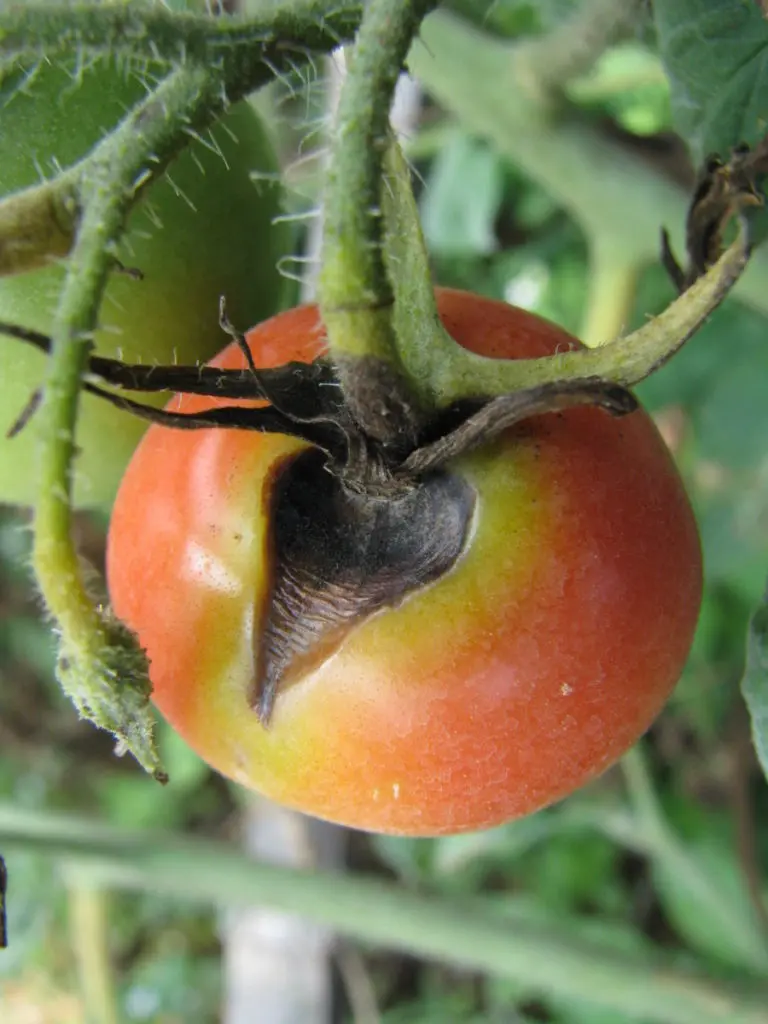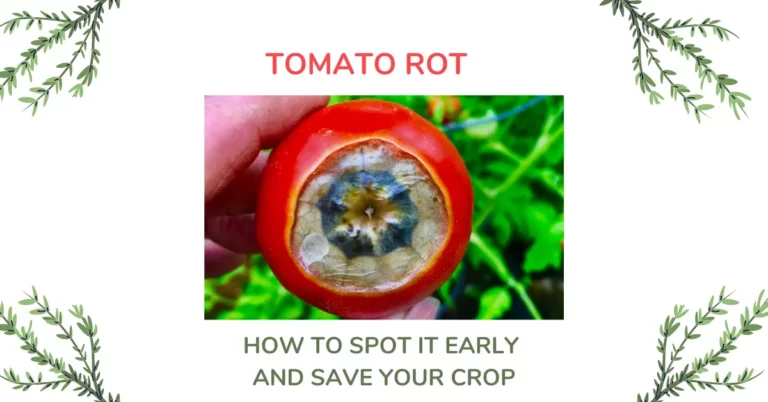Tomato blight spreads quickly through the air during wet periods in the summer. If the weather is cold, it can spread even faster.
The first sign of tomato blight is round brown spots on the leaves. The spots can have yellow and green round edges. The next step is spreading to the flower and main stems. The dark spots will get blacker and darker, eventually killing the whole plant debris.
You can take care of the plant as best as possible and apply a tablespoon of nutrients every 5 weeks. You can tie the plant to a trellis or bamboo for additional support. Also, you can remove the suckers, make sure the rainwater drains properly, cut off a healthy leaf from time to time, inspect the plants regularly or cut away the affected leaves as soon as you notice them.
What Is Tomato Blight and what does it look like?
If you mention the word “blight” in a room filled with gardeners, you will hear nothing but grunts and groans while seeing disappointing faces. This disease attacks tomatoes and potatoes and can kill the tissue of the leaves while destroying the plant.
If you have a garden, the chances are that tomatoes are your first choice of crops. They are versatile and easy to grow.
Plant tomatoes are incredibly prone to illnesses and pests, and your whole harvest can be, if not gone, tackled. Tomato blight, as we mentioned, is a fungal illness that can quickly spread during wet and cold autumn days.
So, how do you identify this disease on time and prevent it from spreading even further?

How to identify tomato blight?
The first signs of tomato blight are discolored and curly leaves in your garden. The tomatoes will have nasty spores and cracks. At that point, you can be sure that you need to intervene. Also, you should not immediately give up on your plant. That is the message behind our article, and we will help you in every way we can.
The first sign of the disease is circular spots on the leaves with yellowish and green edges. The infection after that spreads to the main and flower steps, and the areas will become much darker.
Despite the leaves, the tomatoes will now show brown spots and become very sick. Lastly, when the leaves become gross and wilted, that is when the plant is slowly dying.
What is Blight?
Blight is a disease that spreads by fungal spores that can be carried by the wind, water, insects, and animals from infected plants. Without any intervention, blight can be detrimental. This disease is what caused the Irish Potato Famine in 1840.
To progress, blight requires moisture, so when the tomatoes receive drops of rain, they get in touch with the fungal spores in the soil that eventually reproduces. After the wet weather, water splashes on the soil, and blight will show its first symptoms. Despite scientists not having an actual cure yet, there are a couple of ways that this infection can be controlled if not prevented.
This infection generally first appears on older leaves of the plant and eventually spreads to the newer ones, making its way to the fruits. The subsequent treatment and the correct symptoms depend on what type of blight you are battling against.

Types of Blight
Tomato crops can be infected with three different types of blight, and each one causes various levels of damage. If you notice blight-like lesions on your tomatoes, you could be dealing with:
Late Blight
Being the most common type of infection, late blight is basically “tomato blight.” This disease is caused by the Phytophthora infestans, the fungus that led to the devastating potato famine in Ireland in the 19th century. We mentioned this incident just to give you a general idea of how much damage late blight can cause.
Signs
The infected leaves of the tomato plants will develop dark spores soon after infection. Their appearance will be noticeably different, and some may look irregular and discolored. The damaged areas on the crops may develop some yellowish color, and the stems will become black. Fruits will begin to turn brown and usually rot from the top. Compared to early blight and Septoria leaf spot, late blight attacks in cooler weather.
Early Blight
Early blight is another type of infection that you need to look out for. The fungus is caused by Alternaria solani and makes a home in the soil. Waiting for the right moment, early blight can pop up when you least expect it and when conditions are right, successfully damaging your potato and tomato plants. This fungus thrives when there are wet and humid weather conditions.
Signs
If your fruits are infected with early blight, the darker spots will first appear on the older leaves. You will notice that the dots look like a bullseye. If the infection spreads, the newly infected leaves will also have dark spots on the tomato fruits.
Septoria Leaf Spot
Despite being the easiest blight to control with many options for treatment, it can still damage your plants. The trick here is to catch the Septoria leaf spot early in the growing season.
Signs
Septoria leaf spot primarily attacks the leaves closest to the ground and works their way up. Starting from the soil and making its way onto the crops, this disease can appear in the form of small rounded spots that are yellow and eventually turn black.

Tomato Blight Prevention
Just like diseases with people, some things are out of our control. It may be easier said than done, but what you can do about blight is to take care of your plants as best as possible before applying any chemical.
You can add an extra tablespoon of nutrients monthly and tie the plant to a trellis or bamboo for additional support. For extra good care and to save your tomatoes from this illness, you can also try:
Removing The Suckers
For this operation to be successful, you need to remove the suckers from your tall tomatoes immediately after noticing them. That said, you can also ensure that rainwater drops on the plants and their leaves properly. If you see some healthy leaves between the infected ones with dark spots, cut them off. This way, the tomato plant will have more room to breathe.
Regular Inspection
By regularly inspecting and pruning your tomato plants, you can ensure that everything goes to the plant and that there are no potential blight spores in your garden. Regardless of your tomato varieties, you can do a frequent check-ups, especially on warm wet days. Plus, you can find an excuse and visit your beloved greenhouse almost daily. On top, if anything looks susceptible, you can catch it on time.
Cut Off Affected Leaves
The affected leaves from blight can be easily spotted even in crops. You should cut them away, together with the tainted tomatoes. If you do this on time, you will need no chemical assistance, and the fungicides may no longer spread.

Cut Off Ugly Leaves
Ugly may be a strong word, but you should regularly cut off the weird-shaped leaves because they are more susceptible to fungus than healthy ones. After a humid season and a lot of rain, the healthy, good-looking leaves will dry off better, ripping your tomato fruits faster and leaving fewer leaves to block the sun.
Pay A Close Attention To Your Tomato Fruits
If you have done everything we mentioned above and pruned back the sickly leaves from the fruits, you still need to keep a close eye on them. After you notice another brownish leaf, quickly cut it off. Remove the entire plant if you see nothing but brown color, and all the signs point that blight has spread to many parts of the crops. If you don’t do so, the fungus can rest in the soil, and you won’t be able to plant any delicious tomato fruits in the next couple of years.
Be Aware Of Your Surroundings
If your garden is safe, but the crops around it have blighted potatoes and tomatoes, there are big chances that your greenhouse is next. If you are a part of a community garden or your neighbors have infected plants, it is super important that you constantly monitor your tomato fruits.

Every Tomato Has A Different Vulnerability
While dealing with concentric rings and fruit diseases, not every tomato is equally susceptible to blight. For instance, the entire cherry tomato family is much more resilient and can definitely give resistance to every disease. A cherry tomato is more expensive than a regular tomato.
Save Your Tomatoes
If you discover that your tomato fruits have blight, but you still have some of them that have not ripe, don’t lose hope and give them up just yet. You can pick the tomatoes that have no brown spots and look appealing and put them all in one bowl.
Before putting a plastic bag around them, add a ripe banana. Next, place the bowl on a windowsill that catches the most sunlight. Check them regularly because a study has shown a good chance they will turn into their beautiful bright red color in the next couple of days.
Final Verdict
Tomato blight is a term that makes gardeners shiver. It can damage the fruits and spread by wind and water-splash. This fungal infection can attack potatoes and tomatoes, especially during humid and warm conditions. The outdoor fruits are more susceptible than those in a greenhouse.







